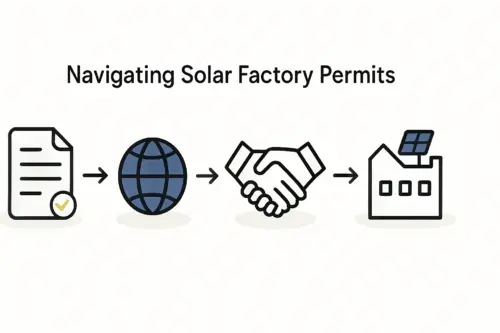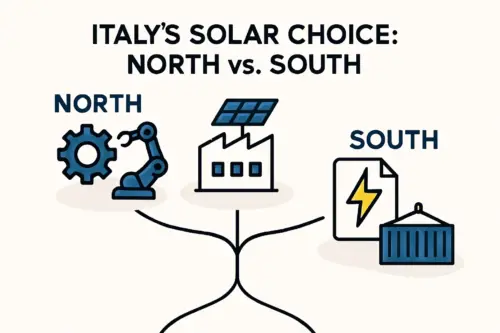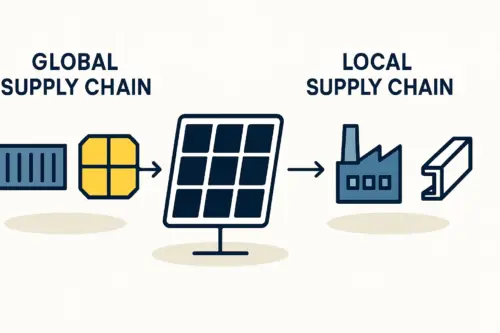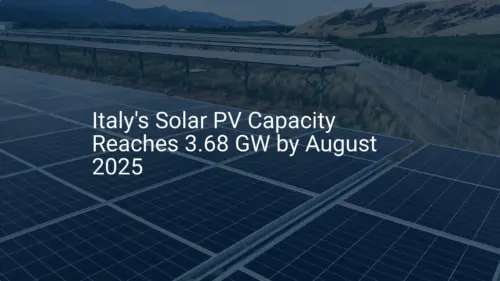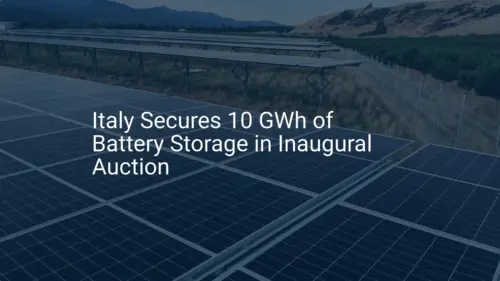Imagine an entrepreneur evaluating sites in Europe for a new solar module factory. The high operational costs and significant initial capital investment often pose formidable barriers. A recent Italian government initiative, however, fundamentally changes this calculation.
For an investor with the right strategy, what was once a high-cost venture can now become a government-supported, financially optimized entry into one of Europe’s most promising solar markets.
This initiative, the Transizione 5.0 plan, is not merely a subsidy but a comprehensive industrial strategy designed to attract investment in green and digital technologies. This guide breaks down the plan’s structure, explores its specific benefits for solar module manufacturing, and outlines the steps required to leverage this opportunity for a new factory in Italy.
What is the Transizione 5.0 Plan?
The Transizione 5.0 plan is a €13 billion initiative for 2024-2025 aimed at accelerating Italy’s dual transition towards a green and digital economy. It provides significant tax credits to companies that invest in new assets that improve energy efficiency.
Its core principle is simple yet powerful: the plan rewards businesses that not only invest in modern equipment but also demonstrably reduce their energy consumption. For the energy-intensive process of solar module manufacturing, this dual focus offers a unique opportunity to reduce both initial capital expenditure and long-term operational costs.
The mechanism is a tax credit that reduces a company’s future tax liabilities, directly improving the project’s return on investment.
Key Investment Pillars Supported by the Plan
The Transizione 5.0 framework is built on three main categories of eligible investments. For a new solar module manufacturing facility, these pillars align perfectly with the necessary project components.
Pillar 1: Capital Goods for Digital and Green Transition
This is the central pillar for a new manufacturing setup. It covers investments in new tangible and intangible assets that are technologically advanced and interconnected with the factory’s management systems. For a solar factory, this includes [Internal Link: /solar-module-manufacturing-equipment | Anchor: essential production equipment] such as automated stringers, high-efficiency laminators, and advanced solar simulators. The key condition is that these machines must be part of a project that reduces the overall energy consumption of the facility.
Pillar 2: Photovoltaic Production and Energy Storage
The plan explicitly incentivizes investments in assets used for the production of photovoltaic panels, making the solar manufacturing sector a primary beneficiary. Furthermore, it supports investments in self-consumption renewable energy systems. This means an entrepreneur can receive tax credits for both the main production line and a rooftop solar installation on the factory itself, creating a highly efficient, circular energy model that significantly lowers electricity costs.
Pillar 3: Employee Training for New Technologies
A modern factory is only as effective as its operators. Recognizing this, Transizione 5.0 offers tax credits for expenses related to training personnel on the use of new, efficiency-enhancing technologies. This is a critical but often underestimated component of a successful factory launch, ensuring that the new, advanced machinery is operated at its full potential from day one.
Ready to make big Profits?
The solar Industry is Booming
WE HELP NEWCOMERS to the solar industry start their own solar module production line. Customers can make BIG PROFITS by selling modules and finding investors, without wasting money and time on things they don't need!
Understanding the Tax Credit Mechanism: How It Works
The value of the tax credit is directly proportional to the level of energy savings the investment achieves. To qualify, a project must result in one of the following:
- A reduction in the production facility’s total energy consumption of at least 3%.
- A reduction in the energy consumption of a specific process line of at least 5%.
The tax credit is then calculated as a percentage of the total investment cost, based on the documented energy savings:
- 35% tax credit for projects achieving at least a 3% reduction in total consumption (or 5% in process consumption).
- 40% tax credit for projects achieving at least a 6% reduction.
- 45% tax credit for projects achieving at least a 10% reduction.
To put this into context, consider a hypothetical example. For an entrepreneur planning an initial machinery [Internal Link: /solar-factory-investment-costs | Anchor: investment in a new solar factory] of €5 million, selecting equipment that achieves a 6% energy reduction could result in a €2 million tax credit. This credit is then used to offset tax payments over five years, substantially altering the project’s cash flow and payback period.
The Application and Certification Process: A Step-by-Step Overview
Accessing the Transizione 5.0 benefits requires a structured and well-documented process. It is not an automatic rebate but a formal procedure managed by Italy’s energy services agency, the Gestore dei Servizi Energetici (GSE).
Step 1: The Ex-Ante Certification
Before the investment is made, an independent, qualified expert must produce an “ex-ante” (before-the-fact) certification. This document validates the project plan, confirms the chosen assets are eligible, and provides a technical analysis projecting the expected energy savings. This critical step forms the foundation of the application.
Step 2: Communication with GSE
The project details, investment plan, and ex-ante certification must be submitted to the GSE. This formally registers the project and reserves the corresponding tax credit amount, subject to final verification.
Step 3: Investment and Implementation
Following the GSE’s preliminary approval, the company can purchase and install the equipment as outlined in the certified project plan.
Step 4: The Ex-Post Certification
Once the new production line is operational, an “ex-post” (after-the-fact) certification is required. This second report, from an independent expert, confirms the investment was implemented correctly and verifies the projected energy savings have been achieved.
Step 5: Claiming the Credit
With the final ex-post certification submitted to the GSE, the company can begin using the tax credit to offset its tax payments in the following fiscal years. Navigating this multi-stage process requires precise technical documentation. This is where the value of a comprehensive [Internal Link: /turnkey-solar-factory-setup | Anchor: turnkey factory plan] becomes evident, as it provides the necessary technical specifications and performance data for the certifications.
Frequently Asked Questions (FAQ) for New Investors
What is the difference between a tax credit and a direct grant?
While a direct grant provides a company with cash, a tax credit reduces its tax liability. This is highly valuable for a profitable enterprise, as it directly cuts tax payments, but it does require the company to have a tax bill to offset.
Can I apply if I am not an Italian company?
The incentive is for investments made in Italy by companies that are tax residents here. A foreign investor would need to establish an Italian subsidiary or other legal entity to undertake the project and benefit from the plan.
Does this plan apply to used machinery?
No. The Transizione 5.0 plan is exclusively focused on promoting investment in new, state-of-the-art assets that meet high standards of energy efficiency and digital integration. Used equipment is not eligible.
How do I prove energy savings?
Energy savings must be proven through mandatory third-party certifications. The ex-ante certification establishes a baseline and a projection, while the ex-post certification provides a technical audit of the actual performance after implementation. This data-driven approach requires detailed and accurate measurement.
Conclusion: A Strategic Entry Point into European Solar Manufacturing
Italy’s Transizione 5.0 plan represents far more than a simple financial incentive. It is a strategic framework that significantly de-risks and accelerates entry into the European solar manufacturing sector. By aligning financial rewards with energy efficiency, it encourages investors to build modern, competitive, and sustainable factories from the outset.
The benefit is twofold: the plan lowers the formidable initial capital barrier while promoting a design that ensures lower long-term operational costs.
For investors evaluating this opportunity, the most critical step is developing a robust business and technical plan fully aligned with the requirements of the Transizione 5.0 framework. This careful and informed planning is the key to unlocking these substantial benefits.





